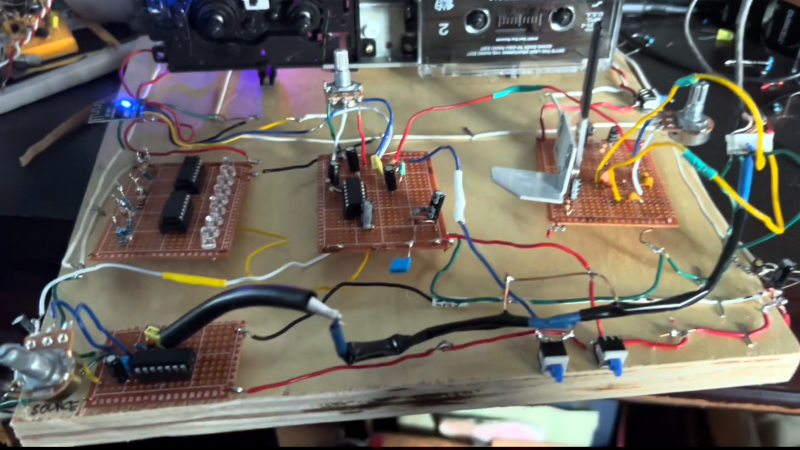If you want to read something from magnetic tape, you need a tape head, right? Or you could do like [Igor Brichkov] and make your own. It looks surprisingly simple. He used a washer with a small slot cut in it and a coil of wire.
The first experiment, in the first video below, is using a commercial tape head connected to a preamp. Music playing “through” the homemade head is readable by the commercial tape reader. This is a prelude to creating an entire tape deck using the head, which you can see in the second video below.
The homemade deck is a collection of small protoboards along with some hodgepodge components, a Bluetooth board, and aluminum foil shielding. One of the protoboards has a simple VU meter using eight LEDs.
We aren’t sure what possessed [Igor] to want to make a tape deck, and — to be fair — it looks like he borrowed the transport mechanism from a commercial player. But we never really need an excuse to build something cool, so we appreciate him sharing his DIY tape deck with us and the world.
If you want to know just about anything related to tape decks, we have some suggested reading for you. If you have trouble finding parts for your cassette collection, maybe fire up your 3D printer.

















I recently built a tape player (just a player) out of a full logic car radio cassette player (no erase head, so no recording). The player mech was virgin but the radio was coded, so I reverse-engineered the mechanism and wrote a small Atmega program. Then I dug out a VFD I salvaged off an old VCR which had a 4 digit display and all the tape transport symbols you wanted and I always wanted to drive a VFD off an Atmega. Turned out I overengineered it. I expected I needed 24-30V for the VFD, but it is plenty bright at 20V and still usable but a bit dim at 12V. CMOS Logic (4000 series) tolerates 20V. The bank of 74LS06 controlling a bank of transistors was totally unnecessary.
Anyway if you wanna have a look: http://tempect.de/senil/tapeplay.html
(I still think it’s too insignificant for a HaD article – everything is just a step above Hello World – although *EVERYTHING* is a step above Hello World…)
Nice! Definitely HaD worthy.
beautiful!
Its worthy to atleast send it to the suggestion page. maybe one of their writers can contact you for some details or a video of it in action to drop in the article. (or an translation). It sure looks intresting :D
From the pictures, your project is *in no way* too insignificant for HaD. Hell, that’s the kind of thing I come here to read! Who hasn’t wondered how to read tapes or drive VFD’s?
All it needs is a schematic — and an English translation, since I don’t know what I presume to be German. :)
Thanks for sharing it!
(and yes, I’m aware of Google Translate. It never gets things quite right :)
Well, that was supposed to be a reply to Senile over there. Bah.
Thanks y’all.
I’ll probably make a video about it and give it some upgrades, I have still some unused I/O, I wanted to implement memory and music search. But the device does the job and I’m lazy and I’ve done what I wanted to do. (and also one of the wires came loose and pretty much write-protected the firmware that’s currently on it, so to upgrade, I’d have to waste another couple pennies for a new Atmega, oh noes!)
I’ll also probably scan the “schematics”, because the overengineered method of driving a VFD might be to use for you – huge VFDs need higher voltages.
(I put schematics in quotes because just with my alarm clock that was actually featured on HaD, if I have to build the same circuit a dozen times, I only paint it once)
The gap in the washer looks like it’s about 1 mm, which is huge. High frequency playback performance would be terrible. Real cassette playback heads have gaps of about 2 microns.
It appears that he’s magnetized the real head, which means he’s going to damage any recording he plays with it.
Good catch! :-)
The real head is fine. Not magnetized. Needs much more powerful magnetic field to do that.
The washer slot is less than a mm but i can’t get it smaller than that with crude tools i have.
Best way is to have v shaped notch from inside and grind away from the outside. However, the diy head as it is will record but not capture high frequencies. But if you have the tools to do that you can totally make one that plays and records
Next step, make a diy lto drive (lto 6 minimum for moonshot)
LTO-6? Too easy ;-)
Just kidding. But would be impressed and interested with already 7/9 tracks 800/1600/3200/6250 BPI, or various QIC family tapes!